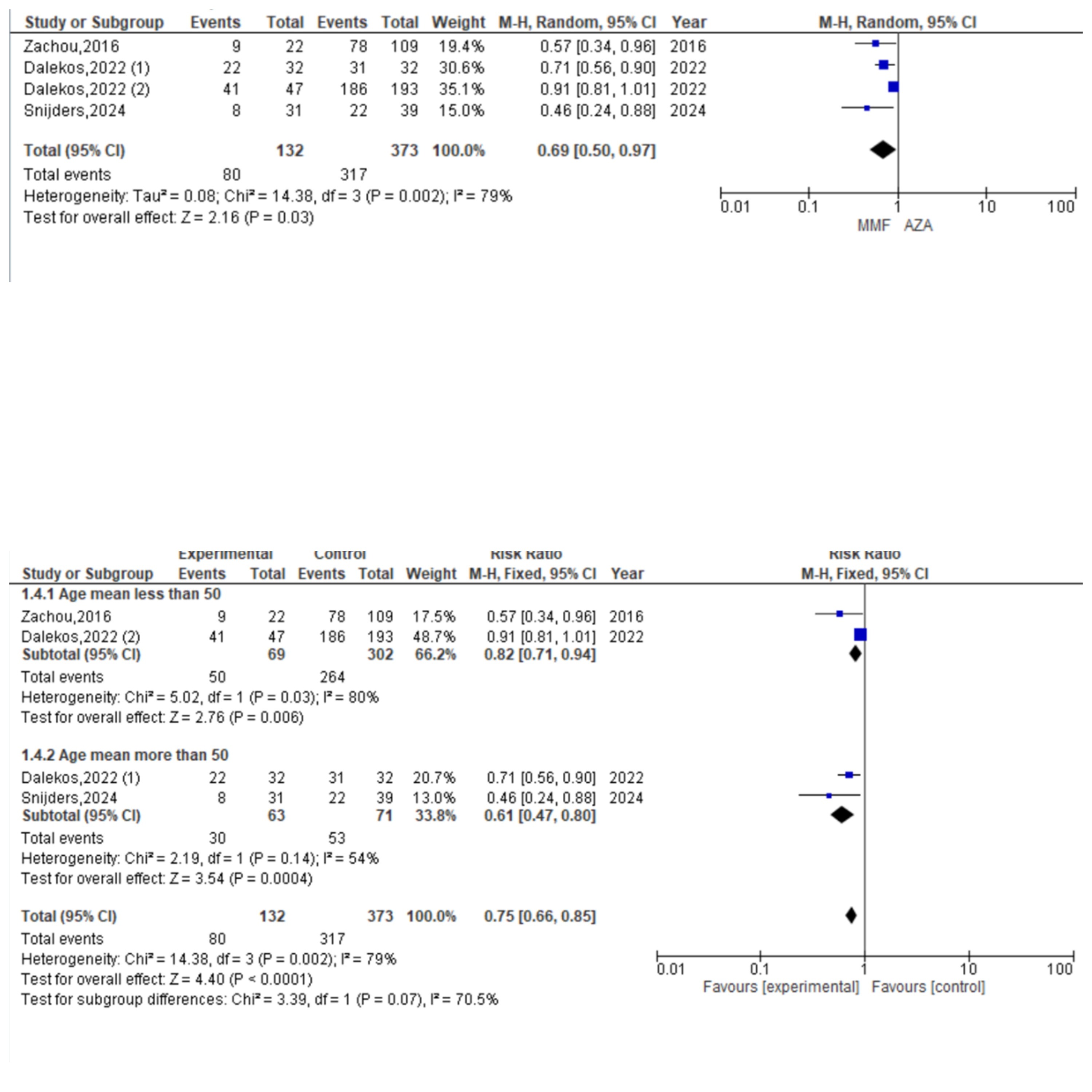Back
Oral Paper Presentation
Annual Scientific Meeting
Session: Plenary Session 4A - Liver
55 - Comparative Efficacy of Mycophenolate Mofetil vs Azathioprine in Autoimmune Hepatitis: A Systematic Review and Meta-Analysis
Wednesday, October 30, 2024
8:30 AM – 8:40 AM ET
Location: Terrace Ballroom 1
.jpg)
Bisher Sawaf, MD
University of Toledo
Toledo, OH
Presenting Author(s)
Momen Mohamed Ibrahim, MBBCh1, Noheir Fathy, MBBCh2, Momen Hassan Moussa, MBBCh1, Mayar Ibrahim, MBBCh1, Mhd Kutaiba Albuni, MD3, Bisher Sawaf, MD4, Karam Motawea, MD1
1Alexandria University, Alexandria, Al Iskandariyah, Egypt; 2Aswan University, Aswan, Aswan, Egypt; 3TriHealth, Doha, Ad Dawhah, Qatar; 4University of Toledo, Toledo, OH
Introduction: Azathioprine (AZA) is the standard treatment for both induction and maintenance of response in autoimmune hepatitis (AIH). However, lifelong administration is typically required, and the combination therapy of prednisolone and azathioprine raises significant concerns regarding efficacy and tolerability, especially given the high relapse rates following AZA cessation. Consequently, there is a need to explore alternative treatment options. This systematic review and meta-analysis compared the efficacy and safety of mycophenolate mofetil (MMF) versus AZA, both in combination with prednisolone, for the treatment of AIH.
Methods: PubMed, Cochrane, Scopus, and Web of Science were searched to identify randomized clinical trials and cohort studies comparing AZA and MMF for the treatment of AIH. Steroid withdrawal and complete biochemical response (CBR) were compared between the MMF and AZA groups in four studies. Subgroup analyses were performed based on age (above and below 50 years) and IgG levels (above and below 2400 mg/dL). RevMan (version 5.4) software was used for the meta-analysis
Results: Five studies comprising 505 patients were included in the final analysis. The pooled analysis showed a statistically significant association between the MMF group and increased CBR compared with the AZA group (RR= 0.69, 95% CI: 0.50 to 0.97), with no significant difference between the two groups regarding steroid withdrawal.
Subgroup analysis by age revealed a significant association between the MMF group and increased CBR in patients over 50 years (RR= 0.61, 95% CI: 0.47 to 0.80), and a significant association between the MMF group and increased biochemical remission compared with the AZA group in patients under 50 years (RR=0.82, 95% CI: 0.71 to 0.94).
IgG subgroup analysis indicated a significant association between the MMF group and increased biochemical remission compared with the AZA group in patients with IgG levels less than 2400 mg/dL (RR=0.61, 95% CI: 0.47 to 0.80).
Discussion: The use of MMF was significantly associated with increased CBR compared to AZA in patients with AIH. Additionally, there was no significant association between the two groups regarding steroid withdrawal. Further research is needed to fully elucidate the optimal treatment strategy for AIH patients across different subpopulations.

Disclosures:
Momen Mohamed Ibrahim, MBBCh1, Noheir Fathy, MBBCh2, Momen Hassan Moussa, MBBCh1, Mayar Ibrahim, MBBCh1, Mhd Kutaiba Albuni, MD3, Bisher Sawaf, MD4, Karam Motawea, MD1, 55, Comparative Efficacy of Mycophenolate Mofetil vs Azathioprine in Autoimmune Hepatitis: A Systematic Review and Meta-Analysis, ACG 2024 Annual Scientific Meeting Abstracts. Philadelphia, PA: American College of Gastroenterology.
1Alexandria University, Alexandria, Al Iskandariyah, Egypt; 2Aswan University, Aswan, Aswan, Egypt; 3TriHealth, Doha, Ad Dawhah, Qatar; 4University of Toledo, Toledo, OH
Introduction: Azathioprine (AZA) is the standard treatment for both induction and maintenance of response in autoimmune hepatitis (AIH). However, lifelong administration is typically required, and the combination therapy of prednisolone and azathioprine raises significant concerns regarding efficacy and tolerability, especially given the high relapse rates following AZA cessation. Consequently, there is a need to explore alternative treatment options. This systematic review and meta-analysis compared the efficacy and safety of mycophenolate mofetil (MMF) versus AZA, both in combination with prednisolone, for the treatment of AIH.
Methods: PubMed, Cochrane, Scopus, and Web of Science were searched to identify randomized clinical trials and cohort studies comparing AZA and MMF for the treatment of AIH. Steroid withdrawal and complete biochemical response (CBR) were compared between the MMF and AZA groups in four studies. Subgroup analyses were performed based on age (above and below 50 years) and IgG levels (above and below 2400 mg/dL). RevMan (version 5.4) software was used for the meta-analysis
Results: Five studies comprising 505 patients were included in the final analysis. The pooled analysis showed a statistically significant association between the MMF group and increased CBR compared with the AZA group (RR= 0.69, 95% CI: 0.50 to 0.97), with no significant difference between the two groups regarding steroid withdrawal.
Subgroup analysis by age revealed a significant association between the MMF group and increased CBR in patients over 50 years (RR= 0.61, 95% CI: 0.47 to 0.80), and a significant association between the MMF group and increased biochemical remission compared with the AZA group in patients under 50 years (RR=0.82, 95% CI: 0.71 to 0.94).
IgG subgroup analysis indicated a significant association between the MMF group and increased biochemical remission compared with the AZA group in patients with IgG levels less than 2400 mg/dL (RR=0.61, 95% CI: 0.47 to 0.80).
Discussion: The use of MMF was significantly associated with increased CBR compared to AZA in patients with AIH. Additionally, there was no significant association between the two groups regarding steroid withdrawal. Further research is needed to fully elucidate the optimal treatment strategy for AIH patients across different subpopulations.

Figure: subgroup analysis of age and steroid withdrawal
Disclosures:
Momen Mohamed Ibrahim indicated no relevant financial relationships.
Noheir Fathy indicated no relevant financial relationships.
Momen Hassan Moussa indicated no relevant financial relationships.
Mayar Ibrahim indicated no relevant financial relationships.
Mhd Kutaiba Albuni indicated no relevant financial relationships.
Bisher Sawaf indicated no relevant financial relationships.
Karam Motawea indicated no relevant financial relationships.
Momen Mohamed Ibrahim, MBBCh1, Noheir Fathy, MBBCh2, Momen Hassan Moussa, MBBCh1, Mayar Ibrahim, MBBCh1, Mhd Kutaiba Albuni, MD3, Bisher Sawaf, MD4, Karam Motawea, MD1, 55, Comparative Efficacy of Mycophenolate Mofetil vs Azathioprine in Autoimmune Hepatitis: A Systematic Review and Meta-Analysis, ACG 2024 Annual Scientific Meeting Abstracts. Philadelphia, PA: American College of Gastroenterology.

